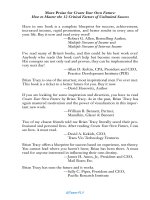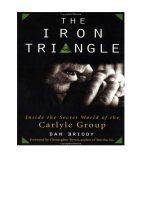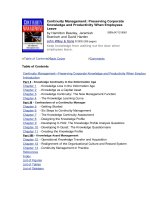John wiley sons making innovation pay people who turn ip into shareholder value mar 2006 tlf
Bạn đang xem bản rút gọn của tài liệu. Xem và tải ngay bản đầy đủ của tài liệu tại đây (2.68 MB, 225 trang )
Making Innovation Pay
People Who Turn IP
into Shareholder Value
Edited by Bruce Berman
John Wiley & Sons, Inc.
Making Innovation Pay
People Who Turn IP
into Shareholder Value
Making Innovation Pay
People Who Turn IP
into Shareholder Value
Edited by Bruce Berman
John Wiley & Sons, Inc.
This book is printed on acid-free paper. ⅜
ϱ
Copyright © 2006 by Bruce Berman. All rights reserved.
Published by John Wiley & Sons, Inc., Hoboken, New Jersey
Published simultaneously in Canada
No part of this publication may be reproduced, stored in a retrieval system, or
transmitted in any form or by any means, electronic, mechanical, photocopying,
recording, scanning, or otherwise, except as permitted under Section 107 or 108
of the 1976 United States Copyright Act, without either the prior written permission
of the Publisher, or authorization through payment of the appropriate per-copy fee
to the Copyright Clearance Center, Inc., 222 Rosewood Drive, Danvers, MA 01923,
(978) 750-8400, fax (978) 750-4470, or on the web at www.copyright.com. Requests
to the Publisher for permission should be addressed to the Permissions Department,
John Wiley & Sons, Inc., 111 River Street, Hoboken, NJ 07030, 201-748-6011,
fax 201-748-6008, or online at />Limit of Liability/Disclaimer of Warranty: While the publisher and author have
used their best ef forts in preparing this book, they make no representations or
warranties with respect to the accuracy or completeness of the contents of this book
and specif ically disclaim any implied warranties of merchantability or f itness for a
particular purpose. No warranty may be created or extended by sales representatives
or written sales materials. The advice and strategies contained herein may not be
suitable for your situation. You should consult with a professional where appropriate.
Neither the publisher nor author shall be liable for any loss of prof it or any other
commercial damages, including but not limited to special, incidental, consequential,
or other damages.
For general information on our other products and services, or technical
support, please contact our Customer Care Department within the United States
at 800-762-2974, from outside the United States at 317-572-3993, or fax
317-572-4002.
Wiley also publishes its books in a variety of electronic formats. Some content that
appears in print may not be available in electronic books.
For more information about Wiley products, visit our Web site at
.
Library of Congress Cataloging-in-Publication Data
Making innovation pay : people who turn IP into shareholder value / edited by
Bruce Berman.
p. cm.
Includes index.
ISBN-13: 978-0-471-73337-9 (cloth : alk. paper)
ISBN-10: 0-471-73337-7 (cloth : alk. paper)
1. Technological innovations — Economic aspects. 2. Patent licenses.
I. Berman, Bruce M.
HC79.T4M32 2006
658.4'063— dc22
2005031934
Printed in the United States of America
10 9 8 7 6 5 4 3 2 1
For spirited inventors, investors, and strategists whose
imagination and perseverance expand the horizon.
About the Author
B
ruce Berman is president of Brody Berman Associates, Inc. in
New York, a management consulting and communications f irm that
works closely with innovation-based businesses, investors, and assets. The
f irm’s areas of industry focus include information technology, science,
law, and f inance.
Bruce conceived and edited From Ideas to Assets: Investing Wisely
in Intellectual Property ( John Wiley & Sons, 2002), a widely acclaimed
exploration of the business of IP that has been translated into Japanese.
He has implemented public relations, investor relations, marketing, and
business development programs on behalf of more than 200 businesses,
and has counseled many executives, investors, and attorneys.
Bruce is a member of the editorial advisory boards of Intellectual
Asset Management and Patent Strategy & Management. His column, IP
Investor, appears regularly in London-based IAM. Articles, chapters, and
reviews written by him have appeared in many periodicals and books,
including The Book of Investing Rules (Financial Times, Prentice-Hall,
2003), which The Motley Fool called one of the ten most useful investment books. He has been cited as a resource in many business, technology, and IP publications. A previous book which he also edited and
contributed to, Hidden Value: Profiting from the Intellectual Property Economy
(Euromoney Institutional Investor), was published in London in 1999.
vii
viii
about the author
A frequent speaker, Bruce has guest lectured at Columbia University
School of Business and either chaired conferences or moderated panels
for The Wall Street Transcript IP conference on ROI, the Intellectual
Property Owners’Association “patent trolls” conference in Washington,
D.C., and the 2005 Center for Intellectual Property Studies conference
in Gothenberg, Sweden.
Bruce received his Master’s degree in f ilm scholarship from Columbia University, where he taught for three years and also completed course
and comprehensive requirements for his Ph.D. He received his Bachelor of Arts degree with honors in English literature and journalism
from The City College of New York. Bruce lives with his wife and
daughter in Westchester County, NY.
Contents
Acknowledgments
Foreword
by Kevin Rivette, author of Rembrandts in the Attic
Introduction
Chapter 1
Roadblocks or Building Blocks?
xiii
xv
xix
3
by Bruce Berman
Chapter 2
5
Worthy Opponents
Distinguishing Patent Trolls from
Independent Asserters
High-Stakes Poker
A Double Standard for IP Assets
Tolls,Trolls, and U-Turns
7
9
11
14
Turning a Patent Portfolio into a Profit Center
19
by Marshall Phelps
Chapter 3
Prof ile: Hail to the Chief IP Of f icer
ThinkPad®: The Licensing Story
A Virtuous Circle
Four Keys to an Ef fective Licensing Program
Innovative Uses for Innovation Rights
19
23
26
29
30
Seeing through the Illusion of Exclusion
35
by Daniel P. McCurdy
Profile: Purveyor of Quality
IP on the Radar Screen
Gaining Competitive Advantage
35
39
40
ix
x
contents
Chapter 4
IBM Leads the Way
Timing the License
Knowing What You Have
Masterpieces Hang in Museums, Not in Attics
Emerging Models
41
43
46
48
49
On Patent Trolls and Other Myths
53
by Alexander Poltorak
Profile: Knight in Shining Armor
53
A Patent Is a Negative Right
57
Myth #1: “A patent is needed to practice
the invention.”
58
Myth #2: “It is not ‘nice’ to sue for patent
infringement.”
59
Myth #3: “The value of a patent is the same as
the value of the patented technology.”
60
Myth #4: “The patent system is fair.”
61
Do Patent Trolls Really Exist?
Myth #5: “A patent is a tax on innovation.”
Chapter 5
Roadblocks, Toll Roads, and Bridges:
Using a Patent Portfolio Wisely
62
64
67
by Peter Detkin
Chapter 6
Profile: From Trolls to Tolls
67
Shareholders Expect a Return on IP
69
Not All Patents Are Created Equal
72
Deploying Unrelated or Orphan Patents
77
Who Are the Buyers?
79
A Seller’s Paradox
81
Risky Business: Overlooking Patents
as Financial Assets
85
by James E. Malackowski
Profile:Wunderkind
85
contents
Chapter 7
xi
Director and Of f icer Accountability
89
Patent Enforcement Litigation
89
Sarbanes-Oxley–Related Compliance
91
Shareholder Litigation
93
IP-Driven Shareholder Value
95
Performance Measurement
98
Director and Of f icer Responsibility
100
Looking Ahead
101
Who Benefits from Patent Enforcement?
105
by Raymond P. Niro
Chapter 8
Profile: Little Guys Like Him
105
A Patent Is Worthless Without a Remedy
109
When Inventors Fail, Innovation Suf fers
110
Inventors Must Consider Patent Enforcement
112
Patent Trolls and Harassment
114
The Role of Contingent-Fee Representation
115
Large Patentees Are Fighting Back
118
Breaking from the Pack
119
Dispelling the Troll Myth
119
The Danger of Not Enforcing
120
Leveling the Field
121
Global IP in Crisis: The Threat to
Shareholder Value
125
by Bruce A. Lehman
Profile: All Along the Watchtower
125
The Leadership Vacuum
129
The Top U.S. Patentees Are Not U.S. Companies
130
The Dangers of Uncertainty
132
®
Viagra in China
133
An Action Plan
135
Managements Need to Step Up
139
xii
contents
Chapter 9
It Takes More Than Being Right to Win
a Patent Dispute
143
by Ronald J. Schutz
Chapter 10
Profile: Serious Competitor
143
Know Everything That Can Be Known
146
Juries Love a Good Story
147
Identifying Strong Patents
149
Good Guys and Bad Guys
150
Patent Disputes: Measuring Risk and Reward
152
Hedging the Risk
154
Managing Innovation Assets as Business Assets
159
by Joe Beyers
Profile: Master Scout
Legal vs. Business-Led IP Perspectives
Elements of a Business-Led IP Model
How Patent Trolls Af fect Prof its
The Nature of the Unfair Value That
Patent Trolls Can Realize
What Operating Companies Can Do
to Protect Themselves
Chapter 11
Secrets of the Trade: An Inventor Shares
His Licensing Know-How
159
163
165
169
170
173
177
by Ronald A. Katz
Profile: An American Original
The Business Model
Agreements and Fee Schedules
Ongoing Research and Notif ication Program
Litigation: Always a Last Resort
Def ining Success
Index
177
182
186
187
189
190
191
Acknowledgments
I
ncorporating the ideas of leading innovators into a single book is
more dif f icult than it may appear. I am indebted to all those, named
and not, who played a part in the preparation of Making Innovation
Pay. Some were vital to the research, others with securing contributors
and f leshing out my thinking, and still others with organization, content, and design.
Among those whose ideas and feedback helped pave the way for this
book were Keith Bergelt,Wendy Chou, Mike Dunn, Harry Gwinnell,
Bo Heiden,Tomas Kellner, Ron Laurie, Sam Mamudi, Marius Meland,
Ulf Petrusson,Andrew Riddles, Robert Shepard, Herb Wamsley, David
Wanetick, Jof f Wild, and Jim Woods. It also is necessary to mention
the many IP directors, licensing executives, IP lawyers, and bankers
who unself ishly availed me of their knowledge, time, and experience.
Special thanks to Brenda Pomerance, my gracious business partner and
patent attorney.
The help of my humble assistants Shirley Wang, Angelina Lachhman,
and Anuja Gagoomal with proof ing the manuscript and in preparing
many of the charts and tables cannot go unheralded. A hearty thank
you to my Wiley editor Susan McDermott, who had the conf idence
to let me have my way (some of the time) and the constitution to endure
xiii
xiv
acknowledgments
our second collaboration. Thanks also to my loyal production editor,
Natasha Wolfe, and the entire Wiley team.
A special debt of gratitude to my family, Sharon, Jenn, and Tucker, for
putting up with my limited focus during MIP’s gestation and birthing.
Finally, I am profoundly grateful to each contributor to this book
for their trust, patience, and for rising to my challenges and of fering
me theirs.
Foreword
S
o, you’ve picked up Making Innovation Pay, and you’re trying to
understand why you should be spending your time (and money) learning about patents.You might be thinking there are already enough books
on this topic to rebuild New Orleans’ beleaguered levees — and you
may be right. Innovation touches everyone.
But this book is different.
In Making Innovation Pay, Bruce Berman has persuaded, arm-twisted,
and otherwise cajoled today’s most successful patent practitioners into
telling their stories and allowing him to tell theirs. Until now, no book
has discussed innovation in so resolutely clear-eyed, personal, and practical business terms. Bruce Berman’s previous book, From Ideas to Assets,
was a tantalizing and thorough overview of IP possibilities. Making Innovation Pay zeros in on the successes and the people behind them.
Nowhere else will you f ind Ron Katz, one of the most successful
inventors in history, ref lecting on the “trade secrets” of licensing. Two
of today’s great IP litigators, Ron Schutz and Ray Niro, def ine what
it takes to win patent cases and who benef its from them. Corporate
IP of f icers abound in this book, including Marshall Phelps (chief IP
strategist at Microsoft and former head at IBM), Joe Beyers (Marshall’s
xv
xvi
fore word
counterpart at Hewlett Packard), Peter Detkin (IP investor and former
Intel patent chief who coined the term patent “troll”), Dan McCurdy
(ThinkFire CEO and former president of IP business at Lucent and a
key player at IBM Research), and Jim Malackowski (the heavy hitter
running the IP investment bank Ocean-Tomo, who persuaded billionaire Ross Perot to put almost $200 million into an IP capital fund).
Contributors explain the illusion of patent exclusivity and how best
to regard invention rights, realistically, from the perspective of corporate prof it and business advantage. Not to be outdone, Alex Poltorak,
an accomplished physicist and purveyor of IP assets, addresses the controversial patent “troll” issue with a bit of tongue in cheek. As if these
insights were not enough, Bruce Lehman (longest serving USPTO
Commissioner) steps up to help us understand the worldwide impact
wrought by the inf lux of uncertain patents and costly disputes.
This book breaks new ground by giving voice to resourceful and
articulate individuals who have had the courage to brave new trails and
the generosity to share how they do it. Bruce’s own provocative opening chapter,“Roadblocks or Building Blocks?,” sets the tone.
Innovation and patents are transforming the world. With globalization, outsourcing, and offshoring, the world is getting smaller and, as a
competitive playing f ield, f latter. Most companies no longer own all
of their means of manufacturing or distribution. Securing and managing intellectual property rights have emerged from a back-of f ice
legal function to the foundation of corporate strategy. Today, ideas —
and the right to use them — are as much products as microprocessors
and cell phones. To compete, businesses require a centralized IP strategy that facilitates competitive returns and enhances shareholder value.
IP management needs novel and more collaborative business models. Companies and independent inventors alike must learn when and
with whom it may be benef icial for them to share IP rights, and how
these good deeds may also be wise business practices. Relying solely
fore word
xvii
on the exclusionary approaches of the past no longer works. Business
questions need answering: When is it benef icial to a company to help
a community with IP donations, and how is this best accomplished?
How can organizations shape IP policies to create innovation networks
for their advantage? Without new IP thinking, how can companies go
“open” in some parts of the value chain, while creating sustainable
shareholder value in others? How can the world’s IP regimes be harmonized to help global trade? How can the patent offices ensure that society benefits from the highest quality protection? But these are questions
for another book.
Since the publication of my book Rembrandts in the Attic in 1999,
I am frequently called on to speak to senior managements and boards
about assessing IP results. Making Innovation Pay is essential reading for
anyone interested in technology, performance, or value. It is also useful for getting a handle on a new worldview.
Would I buy a copy of this book had I not contributed the foreword?
I’d buy two. One for me, and one for a good friend. Many thanks to
Bruce Berman for providing it.
K EVIN G. R IVETTE
Vice President,
Intellectual Property Strategy
IBM Corporation
Introduction
I
f business is a high wire act, then the business of innovation is like
being shot out of a cannon, blindfolded.
Everyone says innovation is important, but almost no one agrees
on the best way to prof it from it. My inspiration for Making Innovation
Pay is to examine the relationship between ideas, capital, and strong
leadership. Exploring how technology rights become shareholder value
is a pursuit whose time has come.
This book looks at the techniques for achieving the best return on
inventions and provides a glimpse at the people who deploy them. The
ten contributors are all on the leading edge of an emerging industry.
They comprise a veritable pantheon of IP talent, who, I sincerely believe, are making history as they write about it. They are mavericks,
perhaps not universally admired by their adversaries or recognized
by Wall Street, but quintessentially American in their desire to succeed
where none have before them.
In most cases they have amassed signif icant fortunes for their employers, clients, and themselves. Readers interested in science, technology, f inance, investment returns, or the art of the deal should f ind
this book especially enlightening.
Senior managements have been woefully ignorant about how to
identify and use IP assets to enhance shareholder value. Those who have
xix
xx
introduction
been successful with IP often do so despite traditional leadership, not
because of it. Some are changing because they want to, others because
they must.
I have been looking at IP from a business perspective for more than
a decade. My previous books, Hidden Value (1999) and From Ideas to Assets
(2002), attempted to make IP strategy more meaningful to a broader
audience. Making Innovation Pay cuts to the chase. It addresses the questions “Who is making money from IP rights?” and “How are they doing
it?” It also probes what equips some individuals to generate higher IPrelated prof its than others.
It took considerable coaxing to get leading IP asset managers to talk
openly about their experiences. A closed-mouthed group, they normally
prefer to f ly under the radar. The result, I believe, is candid perspectives by and about ten guiding IP lights regarding the role rights play in
enhancing results. Readers who seek from this book a foundation for
discussion and debate will not be disappointed.
The Earliest Innovators
It is no accident that the Founding Fathers embraced invention and IP
exclusivity. Franklin was a renowned inventor; Jefferson was an inventor and designer, as well as the f irst Commissioner of Patents. But it
took the astute market sense of Madison and Hamilton, as well as patentee Lincoln, to understand how competitive forces and innovation
can shape prosperity.
I have had the privilege to get to know all of the contributors and
have worked closely with some of them. In most cases they are atypical,
strong-minded individualists who avoid easy def inition. Until recently,
patents—the exclusive rights that protect inventions—have been used
primarily as a defensive shield. The focus was on freedom to operate
and keeping others out of the market. But today people are f inding
introduction
xxi
new, more effective ways for using patents to maximize shareholder value.
Some of these methods are counterintuitive; others are downright
unpleasant; often, as in the case of patent “trolls,” their complexity can
cause folklore to be confused with fact.
The people who make innovation pay are pioneers. They include
forward-thinking engineers and scientists, financial analysts, and lawyers,
managers and investors. They excel at synthesizing diverse disciplines
and discerning complex markets, and they revel in the art of negotiation. Intellectual property and intangible assets today comprise 80% of
the market value of the S&P 500, yet most CFOs spend barely 20% of
their time managing them. Invention rights have emerged as a valuable
new form of currency and, not coincidentally, a key to the future. I hope
that Making Innovation Pay opens the door.
B RUCE B ERMAN
New York City
January 2006
I
n the world’s history, certain inventions and
discoveries occurred, of peculiar value, on account of
their great efficiency in facilitating all other inventions
and discoveries. Of these were the arts of writing
and of printing, the discovery of America, and the
introduction of Patent-laws.
— Abraham Lincoln, 1859









